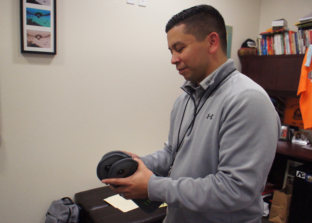
SONY DSC

Yondr, a company that creates magnetic, locking pouches designed to hold electronic devices was founded in 2014 by Graham Dugoni in order to create “phone-free spaces for artists, educators, organizations and individuals.”
In the spring of 2018, 13 teachers at San Mateo High School volunteered to pilot Yondr in their classes. Students would begin each period by putting their phones into the auto-locking pouches and end each class by unlocking their phones with the device placed in each room. According to a survey sent to such teachers by Assistant Principal Adam Gelb, 12 out of the 13 teachers who took part in the piloting program thought that implementing Yondr bell-to-bell across the entire campus would be a good idea.
After the administration proposed plans for fully implementing Yondr to San Mateo’s Parent Teacher Organization, San Mateo chose to allocate money from the school’s community donation fund to purchase enough pouches for each student. Parents initially had concerns about the Yondr’s safety implications, especially in today’s culture of frequent threats of violence against high schools. With what some students may perceive as a looming threat of school shootings, having their phones unlocked and accessible is a way to feel safer at school.
With phones sealed, students would not be able to communicate with people outside of the school, leaving them reliant on the information given to them by people in the same stressful situation as them. Although phone use should not be a student’s main concern in an emergency, quick communication could save someone from unnecessary, and potentially harmful, panic. After much deliberation, the program was green-lit under the impression that it would improve overall student focus and grades and create a more social student body. Buying pouches for the entire student body cost about $16,000. Each pouch costs $15 to $30 depending on school size.
During the 2019-2020 school year, each student received their own Yondr pouch. They were checked out in a similar way as textbooks are; students are responsible for bringing them to and from school each day and paying to replace it if it is damaged. This year alone, dozens of pouches have been broken or damaged, the vast majority done so purposefully.
Days after pouches were distributed, students cheaply purchased strong magnets online to unlock pouches without teachers’ knowledge. Other students brought old phones they no longer used to school in order to keep their real phones unlocked. Some simply broke the pouches, assuming that teachers wouldn’t notice. Although these transgressions are often caught and disciplined, it’s hard to say that the energy on behalf of administrators and consequences inflicted on students are worth not having phones around.
Yondr is enforced by a series of firm consequences for disobedience and extra work on behalf of administrators who perform frequent checks in order to ensure a smooth transition to a completely phone free campus. Although the stringent policy has guaranteed Yondr some success, it has also created resentment within the student body against the program.
Some believe that Yondr’s disciplinary consequences are getting students who were rarely in trouble before sent more often to detentions or Saturday schools because of their rebellions against the program.
“[Yondr] is just going to make people more sneaky with their phones and it’s going to get people that didn’t used to get in trouble into trouble now, because they have a dependency on their phones,” said San Mateo High School senior Manasi Surbe. “It’s not a gradual thing where they [encourage you to] try to use your phone less, but they take the whole thing away.”
To students, Yondr is mostly ineffective. Many would prefer to be able to have their phones unlocked during brunch or lunch, which they believe is their free time, or see it as unfair because they didn’t use their phones at school in the first place. As for teachers, they think it has made students more productive and their job as instructors easier.
“[Yondr] removes one other impediment to learning,” said history teacher Casey Teague. “It moderates the effect of the phone use, it doesn’t completely eliminate it but it takes it off of my plate to have to deal with [and] it puts it back on the student to not get caught with their phone.”
Teachers and the administration see a noticeable difference in school culture because of a lack of phones, both inside and outside of the classroom.
“I would say there’s an intangible improvement in the climate of a classroom. I feel [that] it has an impact upon school culture. It requires students to engage with other human beings and social skills are part of the soft skills that we teach in school,” Teague said. “[Yondr] is a way to enforce those things. [Phones] can be used for all sorts of things [such as] an educational tool, but they can also allow for the kind of anonymity that allows for the worst in human behavior. And I’d like to think that we’re trying to create better people and better stewards of society in the future.”
According to a poll conducted after the fall semester, 88.6% of teachers thought that San Mateo should continue to be a phone free campus for the second semester. San Mateo’s administration is currently figuring out the logistics of continuing the program next school year.
Aragon has not committed to implementing Yondr in the next school year.
“The superintendent is leaving it up to the administration to decide what we do from site to site,” Gelb said.
San Mateo’s PTO raised some concerns that other schools in the district would not be able to afford Yondr unless SMUHSD allocated funds for a districtwide program. Gelb is optimistic that the Superintendent will reconsider his stance on a districtwide policy after a few years of success at San Mateo.



